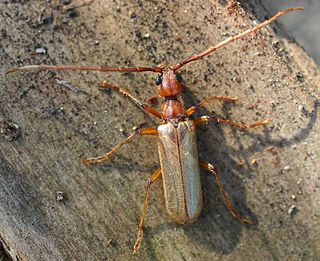
The Asian parti-colored bat is a species of parti-coloured bat. An adult Asian parti-colored bat has a body length of 6–7 cm (2.4–2.8 in), a tail of 4.3–4.5 cm (1.7–1.8 in), and a wing length of 5 cm (2.0 in). Asian parti-colored bats are distributed across East Asia, from Taiwan through eastern China, eastern Mongolia and Russia (Siberia) to the Korean Peninsula and Japan.
Botta's serotine is a species of vesper bat, one of 25 in the genus Eptesicus. It is found in rocky areas and temperate desert.
The dark-brown serotine is a species of vesper bat found in Central and West Africa.

The Vesperidae are a small family of beetles, normally classified within the family Cerambycidae, of heterogeneous aspect but all characterised by larval stages related to roots of herbaceous plants or trees

Anconastes is an extinct genus of dissorophoid temnospondyl within the family Trematopidae. It is known from two specimens from the Late Carboniferous Cutler Formation of north-central New Mexico in the southwestern United States. The genus name derives from two Greek roots, ankos and nastes ("inhabitant"), which refers to the type locality of El Cobre Canyon where the specimens were found. The specific name is derived from the Latin word vesperus ("western"). The more complete specimen, the holotype, is a partial skull with articulated mandibles and a substantial amount of the postcranial skeleton. The less complete specimen, the paratype, consists only of the right margin of the skull with an articulated mandible.

Vesperinae is a subfamily of beetles in the family Vesperidae. It contains two monotypic tribes, Vesperini and Vesperoctenini.
Vesperus barredai is a species of beetle in the Vesperidae family that can be found in Portugal and Spain. Its colour is black, and it has yellow legs and antennae.
Vesperus sanzi is a species of beetle in the Vesperidae family that can be found in Portugal and western Spain.
Vesperus serranoi is a species of beetle in the Vesperidae family that is endemic to the Iberian Peninsula.

Vesperus strepens is a species of brown coloured beetle in the family Vesperidae, found in France and Italy.
Vesperus xatarti is a species of brown coloured beetle in the family Vesperidae, found in the Balearic Islands, France, and Spain.
Vesperus nigellus is a species of beetle in the Vesperidae family that is endemic to Balearic Islands.
Vesperus fuentei is a species of beetle in the Vesperidae family that is endemic to Spain.

Vesperus luridus is a species of beetle in the Vesperidae family
Vesperus jertensis is a species of brown coloured beetle in the family Vesperidae that is endemic to Spain.
Vesperus creticus is a species of beetle in the Vesperidae family that is endemic to Greece.
Vesperus conicicollis is a species of brown coloured beetle in the family Vesperidae, found in Portugal, Spain, and on the island of Sardinia.
Vesperus brevicollis is a species of brown coloured western European beetle in the family Vesperidae, found in Portugal and Spain.

Vesperus is a genus of beetles in the family Vesperidae.
Neoromicia grandidieri, known by the common names of Dobson's pipistrelle and yellow pipistrelle, is a species of vesper bat found in Africa. It was formerly in the genus Pipistrellus



